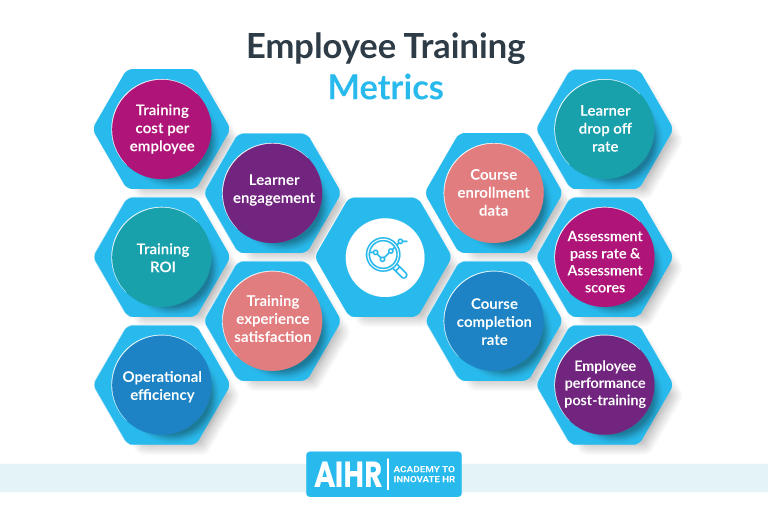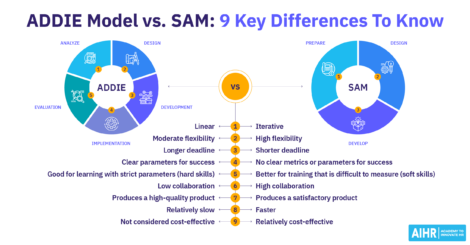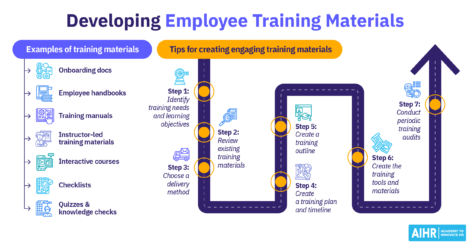10 Employee Training Metrics You Should Know

One of the most famous business quotes comes courtesy of Peter Drucker (the father of management thinking) “If you can’t measure it, you can’t improve it.” The quote is quite apt when it comes to understanding employee training metrics because how else can you show results and make improvements?
Year on year, L&D departments within organizations carefully plan the type of training they need to provide to employees to reach business goals and improve overall business results. But does this actually work? And if it works, is it 100% optimized to achieve the desired outcome?
Executives are typically skeptical about investing money into training without any clear outcomes or metrics. It’s understandable, as there is an increased push to cut costs, and usually, the training budget is one of the first items that is affected.
Tracking employee training metrics helps your organization ensure that the training you provide is engaging and, most importantly, contributing to organizational goals.
Contents
What are employee training metrics?
Why should you use training metrics for training evaluation?
Key employee training metrics
What are employee training metrics?
Employee training metrics serve many functions, including:
- Evaluating the success of a training program.
- Measuring training effectiveness of a program.
- Using data points and insights to align the training the organization’s goals.
- To evaluate different components of a training program.
The main focus of employee training metrics is ‘effectiveness.’ So, let’s say, for example, you work in a company that sells clothes online. In order to drive sales, you need to improve the SEO (search engine optimization) of your website to drive leads and ultimately get more sales. However, after a quick analysis, you realize your employees do not have the necessary SEO skills – so you send them to a training course. The employee training metrics would help answer the following questions:
- Was the training of employees on SEO successful?
- Were the learners satisfied with the training?
- Has there been an increase in sales to the website? Has there been a noticeable increase in leads?
- Is your website more SEO-optimized?
- What is the additional training needed for any further SEO skills?
Within an organization, the training results really become apparent when there is a clear goal in mind linked to the training. Suppose your goal is to increase website visits by 15% over six months. In that case, you’re able to deploy the appropriate level of training to achieve this – and thus, measure training metrics against this specific business metric.
Why should you use training metrics for training evaluation?
Using employee training metrics in training evaluation allows you to make data-driven decisions. It removes bias and avoids decisions being made out of a whim. From an organizational perspective, it creates procedural fairness and gives validity to any financial investment made in training. Moreover, using training metrics allows:
- Financial performance to be measured – You’re able to link training metrics to financial performance metrics (e.g., ROI, liquidity, profitability measures).
- To track performance over time – Using the same metrics and KPIs allows you to observe any noticeable improvement as a direct result of your training efforts.
- Benchmark training to competitors – Using consistent metrics allows you to compare your training program to competitors and measure whether you’re underspending or overspending.
- Communicate transparently to employees – You’re able to show employees the value of training and the value of the investment made in them.
One of the biggest reasons employees leave an organization is due to lack of training. Using training metrics can sometimes be a simple way to show employees the value of the investment made in them. Sometimes it’s not about what is done but how value it is communicated.
Key employee training metrics
In your training evaluation, you can use different training metrics depending on what your goal is – measuring training satisfaction and engagement, planning your training budget, improving your participation and pass rates, or evaluating the business outcomes. Here are 10 common training metrics.
1. Training cost per employee
This is a straightforward metric, which divides the total cost of training by the number of employees. This can be for a specific program or as a sum of all training done in a particular year. The formula would be:
Training cost per employee = cost of training / number of employees
As an example, let’s say your training for the year costs $100,000, and you have 75 employees.
Training cost per employee = $100,000 / 75 = $1,333.33
For instance, the average Training industry found that the average spend per employee annually is $1,046. So, you’re able to measure if you are overspending or if it is justified. What’s more, you can also use this metric to plan your training budget for the following year.
2. Learner engagement
Learner engagement measures the amount of time and effort learners invest into the learning process. It means that learners are actually taking the time to sign up and process the training material produced.
While there is no exact metric to measure this, there are some engagement statistics you can look at. This includes time spent on modules or courses. Most LMS systems have these features built in. Naturally, the more time a learner spends on the learning platform and interacting with its various features, the more engaged they are.
However, this may not always be true, as in some cases, learners are just ‘clicking’ through the modules without learning. That’s why, to measure engagement, you should combine it with other metrics such as course completion, satisfaction rating, and employee performance.
3. Training Return on Investment
Return on investment (ROI) of training measures the efficiency or profitability of the money you put into the training. It is usually linked to greater revenue and business impact. You don’t need to measure ROI of every training initiative at your organization. Typically, you would only track this key metric for the top 5% most impactful training programs.
One of the most popular ways to measure training return on investment is:
Training Return on Investment = (Return of Benefit – Investment Cost) / Investment Cost x 100
Let’s say you spent $45,000 on training to increase the speed of your customer service reps resolving issues. As a result of this, they were able to increase customer satisfaction and sales, which led to an increase of $100,000 in net profit from sales. Therefore:
($100,000 – $45,000) / 45 000 x 100 = 122% return on investment of training.
4. Training experience satisfaction
This is one of the most popular training metrics to measure and can usually be found in a post-training survey. It is used to gauge how satisfied learners are with the training they received. You can use the Net Promoter Score (1 to 10) with the question, “How likely is it that you would recommend this training session to a friend or peer” to gather feedback and measure training experience satisfaction.
This is an excellent metric to assess whether training was successful in the eyes of the learners or not. For NPS, anything between 0 and 30 is good. Anything higher than 30 is great. A score below 0 is something that might start to concern you.
5. Operational efficiency
Training should increase operational efficiency if it is done effectively and addresses the specific skill gaps needed to optimize processes in the workplace.
For example, you might currently be missing 40% of your deadlines. If an employee training program is deployed to address this specific issue, there should be a noticeable improvement (e.g., a decrease to 20% or 5% over time). Operational metrics such as ‘time to repair’, ‘time to recover,’ ‘time to failure,’ ‘cost-per-click’ can be measured before and after training to note any efficiency improvement.
6. Course enrollment data
This is simply to measure how many students enroll in the course. You can use this metric, for example, to improve how you communicate the training to employees.
You may want to use A-B testing here, where you communicate the training program to employees using different messages to measure the effectiveness of different images and email subject headers used when presenting the course.
Furthermore, it also specifies if the training deployed is appropriate for employees. You can do small things to improve course enrollment (such as encouraging managers to promote the course to their teams) and see how it improves over time.
7. Course completion rate
Finally, students have enrolled for your course! But only 50 of the 1,000 enrolled students completed 100% of the course. The course completion rate gives you an indication of how much of the course a student completed.
There are creative ways to encourage course completion, such as gamification and producing bite-sized content.
8. Learner drop off rate
This is again an indication of how many learners either started a course and did not complete it or decided to leave the course. It’s a measure of the quality of the content of the training materials, or it may even indicate browser compatibility issues in online learning platforms. Ideally, you measure where in the course the learners dropped off. That helps you understand if there are problems with a particular piece of the training.
9. Assessment pass rate and Assessment scores
The assessment pass rate measures how many learners passed or failed a course taken. For example, if 200 employees took a test at the end of a course, and only 45 people passed, that would be a pass rate of 22.5%.
It could indicate that the course assessment was difficult, or it may have been purposely done in this way to filter out the best students. If your pass rates and assessment scores are unexpectedly low, you can examine what caused it. Have the students taken too much time to complete the course and forgot what they learned at the beginning? Or were the questions unnecessarily detailed?
Sometimes, passing an assessment is compulsory, and students need to retake it until they pass the course. On a regulatory note, these assessment pass rates and scores are needed when reporting on stats for legal training taken (such as regulatory training required to be compliant as a company).
10. Employee performance post-training
Employee performance post-training looks at the improvement of employee performance overtime related to the training. The impact of training may be immediately noticeable or only after a more extended period of time, dependent on the complexity of the skill being trained on.
You can measure this through tracking employee performance metrics like number of sales or first-call resolution on an individual employee level, or revenue per employee on an organizational level, before and after the training, and comparing the results. Again, like with the training ROI, you would only measure this for your most impactful trainings.
Where do you get this data?
To get the data for your training metrics, you need to look at:
- The Learning Management System – This houses all master data, such as course completion rates, sign-up rates, assessment scores, pass rates, and some engagement metrics.
- Surveys – This helps you gather data such as satisfaction scores and qualitative data on the effectiveness of your training.
- Focus groups – Sometimes, it might be helpful to conduct employee focus groups to have an honest and open conversation about the training received.
- Employee performance data – This houses any measure of improvement in performance seen over time as a result of training.
A final word
Effective employee training is key to future-proofing your organization. That’s why you need to make sure that it’s bringing the results that you want. Tracking the right training metrics helps you ensure this.
Weekly update
Stay up-to-date with the latest news, trends, and resources in HR
Learn more
Related articles
Are you ready for the future of HR?
Learn modern and relevant HR skills, online













